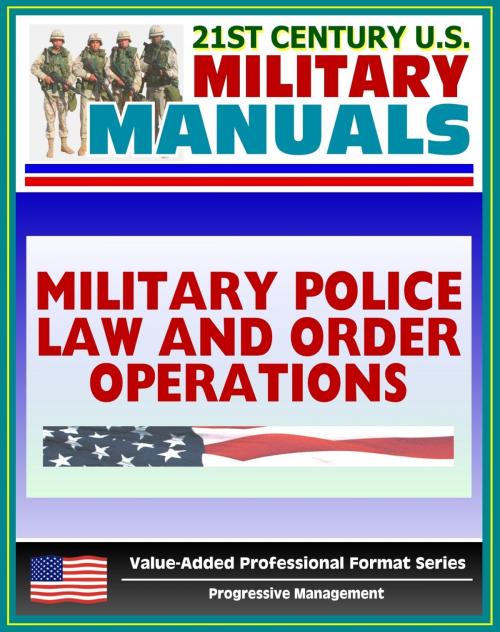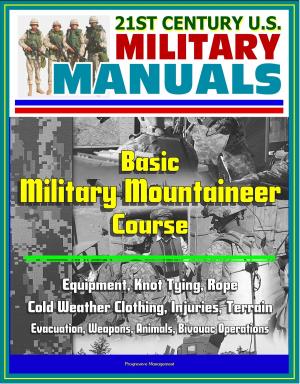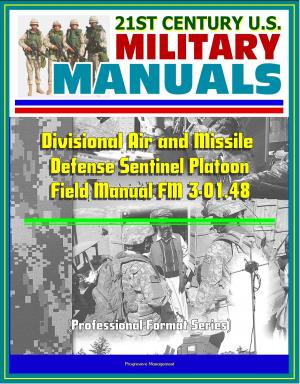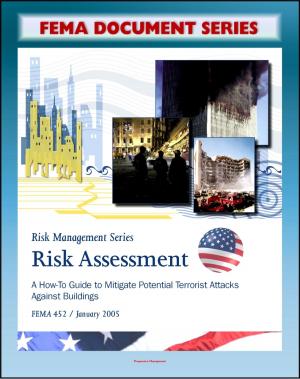21st Century U.S. Military Manuals: Military Police Law and Order Operations FM 19-10 - Patrols, Working Dog Teams, Investigations (Value-Added Professional Format Series)
Nonfiction, Social & Cultural Studies, Political Science, Politics, Law Enforcement| Author: | Progressive Management | ISBN: | 9781465837974 |
| Publisher: | Progressive Management | Publication: | September 6, 2011 |
| Imprint: | Smashwords Edition | Language: | English |
| Author: | Progressive Management |
| ISBN: | 9781465837974 |
| Publisher: | Progressive Management |
| Publication: | September 6, 2011 |
| Imprint: | Smashwords Edition |
| Language: | English |
Professionally converted for accurate flowing-text e-book format reproduction, the Military Police Law and Order Operations field manual (FM 19-10) covers the "law and order" duties of the military police (MP). This field manual (FM) discusses each element of the MP law and order mission. It addresses law enforcement operations, investigations, confinement of US military prisoners, and terrorism counteraction. This field manual will assist military police in understanding how each of these elements is an essential part of their law and order mission. Commanders will find it useful in understanding how MP help support the fulfillment of command responsibilities. Because many aspects of the MP law and order mission are undertaken largely to provide a safe environment for the total Army community, much of the discussion in this FM is devoted to MP law and order responsibilities in a peacetime environment.
This manual is produced by Headquarters, US Army Training and Doctrine Command (TRADOC). In the preface, it states:
"One of the most important missions the Army has is to maintain its readiness. Unit readiness rests on the morale, discipline, and training of its soldiers. It rests equally on having quality soldiers and their families feel good about life in the Army community. Our soldiers and their families must have a safe and secure environment in which to live, work, and train. The military police (MP) accept that challenge daily. MP protect the Army's assets through active physical security measures. And MP undertake a vigorous economic crime program. They guard the Army's people and installations against terrorist threats. Their initiatives in crime prevention and family advocacy and their "work friendly" attitude show they care about soldiers and their families. MP unstintingly fulfill their law and order mission, knowing it to be vital to the Army's success in combat."
Some highlights of the contents:
* Operating Patrols (Methods and Means)
* Conducting Searches and Seizures
* Conducting Apprehensions
* Employing Military Working Dog Teams
* Enforcing Customs Laws and Regulations
* Law and Order Investigations
* Criminal Investigations
* Investigative Means and Measures
* Surveillance and Covert Operations
* Confinement of U.S. Military Prisoners
* Field Confinement
* Terrorism Counteraction
* Protective Services
* Bomb Threats
* Special Reaction Team
As a bonus, this reproduction includes FM-1, The Army Field Manual, a capstone manual containing the vision for the Army - sold separately for $5.99. FM 1 establishes the fundamental principles for employing Landpower. The most important of these are the Army's operational concept and the fundamentals that support it. They form the foundation for all Army doctrine. All Soldiers should understand and internalize them. FM 1 describes the American profession of arms, the Army's place in it, and what it means to be a professional Soldier. Central to this discussion are the Soldier's Creed, Warrior Ethos, and Army Values. These three statements establish the guiding values and standards of the Army profession. To understand Soldiers, you must know about them. To be a Soldier, you must live them. FM 1 discusses Army contributions to the joint force. As the Armed Forces achieve even greater joint interdependence, the Army will depend more on the other Services and vice versa. For this reason, the Army is currently transforming its units and institutions to enhance our campaign qualities for sustained operations and to achieve greater expeditionary and joint capabilities. It is important for Soldiers and all who support or are associated with the Army to understand these contributions and how the Army is transforming to better meet its obligations to the other Services.
This is a privately authored news service and educational publication of Progressive Management.
Professionally converted for accurate flowing-text e-book format reproduction, the Military Police Law and Order Operations field manual (FM 19-10) covers the "law and order" duties of the military police (MP). This field manual (FM) discusses each element of the MP law and order mission. It addresses law enforcement operations, investigations, confinement of US military prisoners, and terrorism counteraction. This field manual will assist military police in understanding how each of these elements is an essential part of their law and order mission. Commanders will find it useful in understanding how MP help support the fulfillment of command responsibilities. Because many aspects of the MP law and order mission are undertaken largely to provide a safe environment for the total Army community, much of the discussion in this FM is devoted to MP law and order responsibilities in a peacetime environment.
This manual is produced by Headquarters, US Army Training and Doctrine Command (TRADOC). In the preface, it states:
"One of the most important missions the Army has is to maintain its readiness. Unit readiness rests on the morale, discipline, and training of its soldiers. It rests equally on having quality soldiers and their families feel good about life in the Army community. Our soldiers and their families must have a safe and secure environment in which to live, work, and train. The military police (MP) accept that challenge daily. MP protect the Army's assets through active physical security measures. And MP undertake a vigorous economic crime program. They guard the Army's people and installations against terrorist threats. Their initiatives in crime prevention and family advocacy and their "work friendly" attitude show they care about soldiers and their families. MP unstintingly fulfill their law and order mission, knowing it to be vital to the Army's success in combat."
Some highlights of the contents:
* Operating Patrols (Methods and Means)
* Conducting Searches and Seizures
* Conducting Apprehensions
* Employing Military Working Dog Teams
* Enforcing Customs Laws and Regulations
* Law and Order Investigations
* Criminal Investigations
* Investigative Means and Measures
* Surveillance and Covert Operations
* Confinement of U.S. Military Prisoners
* Field Confinement
* Terrorism Counteraction
* Protective Services
* Bomb Threats
* Special Reaction Team
As a bonus, this reproduction includes FM-1, The Army Field Manual, a capstone manual containing the vision for the Army - sold separately for $5.99. FM 1 establishes the fundamental principles for employing Landpower. The most important of these are the Army's operational concept and the fundamentals that support it. They form the foundation for all Army doctrine. All Soldiers should understand and internalize them. FM 1 describes the American profession of arms, the Army's place in it, and what it means to be a professional Soldier. Central to this discussion are the Soldier's Creed, Warrior Ethos, and Army Values. These three statements establish the guiding values and standards of the Army profession. To understand Soldiers, you must know about them. To be a Soldier, you must live them. FM 1 discusses Army contributions to the joint force. As the Armed Forces achieve even greater joint interdependence, the Army will depend more on the other Services and vice versa. For this reason, the Army is currently transforming its units and institutions to enhance our campaign qualities for sustained operations and to achieve greater expeditionary and joint capabilities. It is important for Soldiers and all who support or are associated with the Army to understand these contributions and how the Army is transforming to better meet its obligations to the other Services.
This is a privately authored news service and educational publication of Progressive Management.















